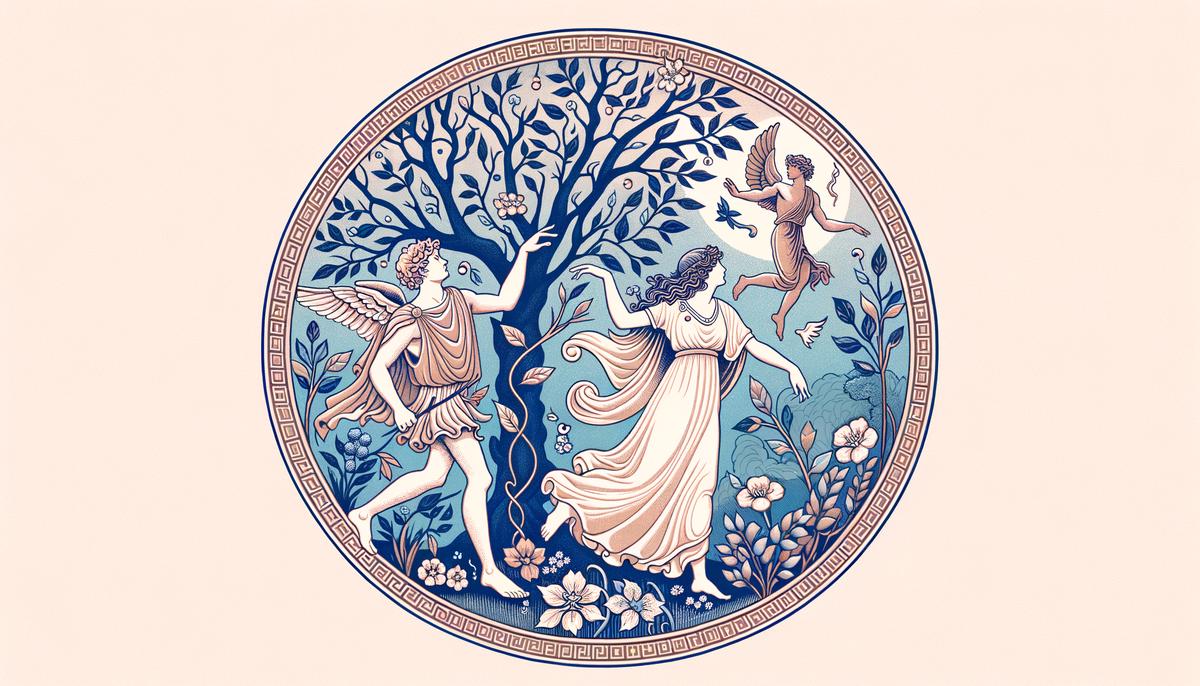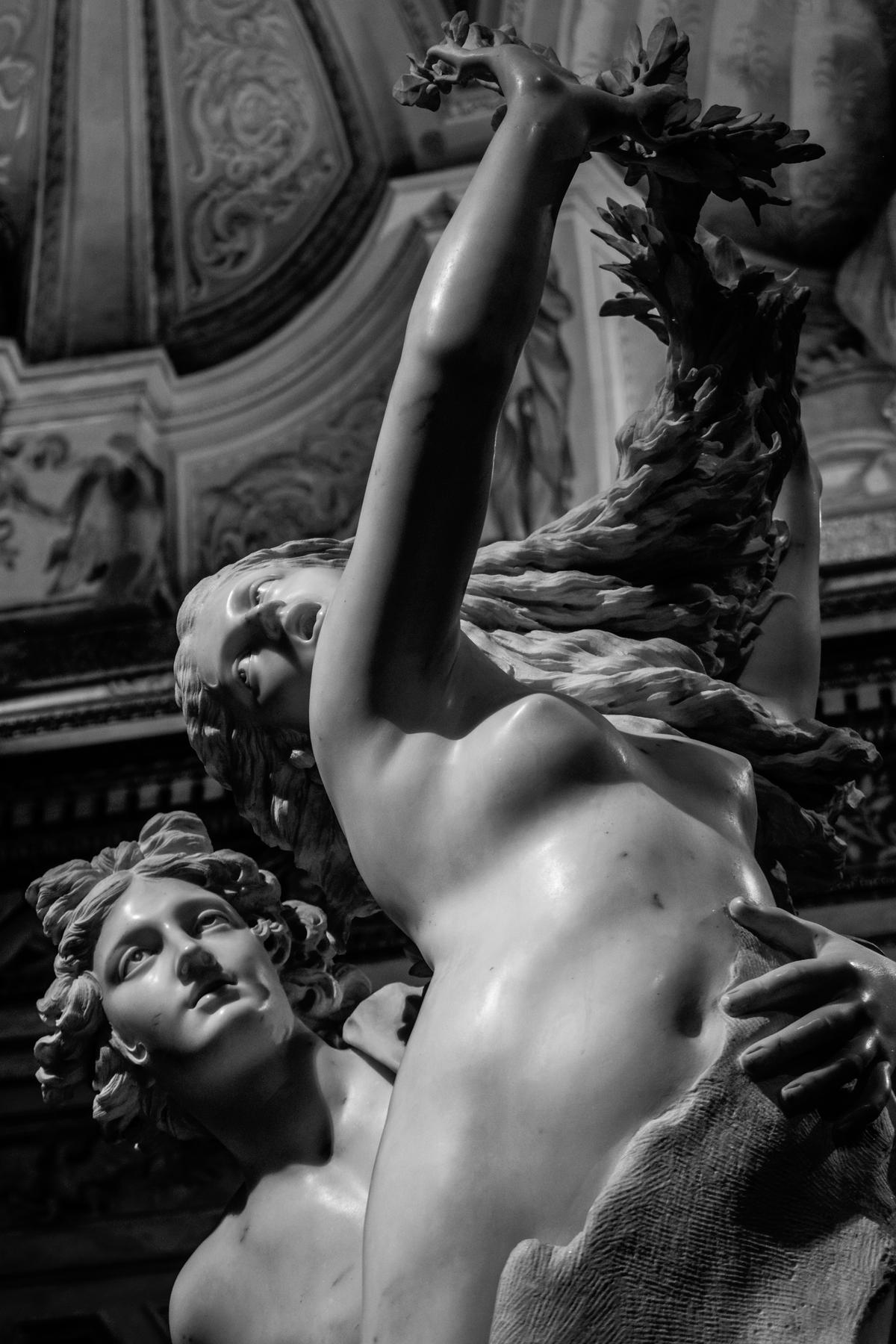The tale of Apollo and Daphne from Greek mythology invites us into a world where the boundaries between the celestial and the terrestrial blur, reflecting deeper truths about human nature and relationships.
Daphne's Origin and Myth
Daphne, meaning laurel in Greek, is the daughter of either Peneus, the river god of Thessaly, or Ladon from Arcadia. Her roots are deeply entwined with nature's elements, symbolizing the flow and dynamism in her story.
Caught in a celestial conflict, Daphne becomes the unintended victim of Cupid's revenge. When Apollo mocks Cupid's archery skills, Cupid retaliates by striking Apollo with a golden arrow of uncontrollable love, while Daphne is hit by a lead-tipped arrow that instills an aversion to affection. It's a clash of divine wills with Daphne caught in the middle.
As Apollo chases Daphne, driven by Cupid's love-inflicted arrow, the desperation escalates until she calls to her father or Earth for salvation. Transformed into a laurel tree at the crucial moment of capture, her metamorphosis is symbolic – merging notions of purity, eternal beauty, and perhaps, tragic evasiveness.
The transformation carried a lasting cultural imprint. Apollo, moved by her enduring beauty, declared the laurel as his eternal symbol. This bound Daphne's image with victory, poetry, and prophetic significance across Greek civilization, seen in laurel wreaths crowning triumphant Olympians or poets.
Apollo's lingering connection to the laurel tree celebrates Daphne's purity while mourning her escape. In poetry and prophecy, the laurel becomes a dual emblem—representing both Apollo's love and Daphne's resistance.
This narrative underlines the transformative power in Greek myths. Unlike folklore where characters have more control over their destinies, Greek mythology places beings at the mercy of gods' whims, revealing darker hues of divine interactions. Daphne's transformation is an allegory for the invasive powers that dictated terms on mortal affairs.
From cultural festivals to artistic renditions, Daphne's leap from a pursued nymph into a stationary emblem of honor enshrines her story in ancient Greece's mythological repository. It exposes the raw blend of charm and coercion typical in tales from this ancient world.

Apollo's Role and Motivations
Apollo's chase for Daphne captures intrinsic themes of desire and devastation, showcasing a deity's nature intertwining authority with overwhelming passion.
Motivated partly by Eros's slight after having his honor questioned, Apollo's susceptibility to Cupid's provocation unveils the colliding domains of divine egotism and rivalries—a captivating quirkiness often seen in Greco-Roman mythology. Apollo, usually portrayed as a paragon of rationality, becomes fervently irrational once consumed by the golden arrow's supernatural allure. Seduced by the head-spinning intoxication of attraction, he ignites with raw yearning for Daphne.
His motivations resonate with poignant, albeit unwise, longing. It's a magnificent opera whose act ascends like the crescendoes in the symphonies he is fabled for—an unsettling mix of prowess battling an equally powerful rejection.
Symbolically, chasing Daphne showcases Apollo's role as the unyielding luminary—the encompassing sun that chars even as it illuminates. Yet, there's tragic irony too. The god of healing cannot heal his own feverish infatuation. His relentless pursuit breaks the perception of infallibility among the gods, laying bare vulnerability in the mighty.
This fervent chase and Daphne's transformation into a laurel—admired but unattainable—echo Apollo's dichotomous nature. Just as he brings light yet diagrams shadowed prophecies at Delphi, he simultaneously worships an untouchable ideal. The laurel wreath encapsulates triumph and poetry, yet its leaves whisper of unfulfilled loves and desires—further embroiled in unending chases, carrying an element of untouchability.
Through Apollo's yearning, Greek mythology explores themes of power: the possession in conquest and the futility when faced with love's defiance. It coaxes deliberations on authority versus autonomy—a vital contemplation resonating as passionately today as it did in ancient times.
The legend of Apollo and Daphne annotates the foibles of divine proportions and provides insights into the chaos entwining power, consent, and emotional pursuit across timeless narratives. In the end, Apollo's desire narrates a tale of aversion converted to symbolized admiration, "planting" lessons in the tendrils of mythic storytelling traditions.
Symbolism of the Laurel
When Daphne transformed into a laurel tree, the imagery evolved into a symbol infused with deep cultural reverence throughout ancient Greece. This transformation encapsulates an allegory about divine intervention and fate's inseparability from human affairs. Laurel, known as 'daphne' in Greek, took on sacred symbolism that exceeded its botanical identity.
In ancient Greek traditions, the laurel was a badge of honor and divine sanction. Connected with Apollo through his affection for Daphne and his influence over victory and the arts, the laurel wreath became an emblem of achievement and moral integrity. Laurel crowns were bestowed upon victors at the Pythian Games at Delphi—games founded by Apollo. These victors were celebrated athletes, poets, and musicians, reflecting the synthesis of physical prowess with artistic mastery.
Laurel wreaths intertwined the victorious with the eternal favor of the gods. Laurel branches were used in ceremonial rites, offering protection and purification. Delphic priests used laurel in rituals to signify communication with the divine, as the leaves were believed to enable prophetic visions when burned.
Its representation in the arts was widespread and indicative of its symbolic charges. Painters and sculptors from antiquity to the Renaissance festooned their work with laurel motifs, embedding within each leaf an immortal story of struggle, beauty, and transformation. The scene of Daphne's metamorphosis became a favored narrative, underscoring the tension between pursuit and resistance, desire and denial.
Apollo's adoration transformed into an unyielding symbol demonstrated how the ancient Greeks understood concepts of love, chastity, and fame. Love, as depicted through Apollo's fruitless chase, speaks to the universal experience of unreciprocated affection and the boundaries one must respect. By weaving laurel into their crowns, literature, and notions of excellence and virtuousness, the ancients communicated a philosophy resonating through ages—a dialogue between nature, humanity, and ethereal realms.
The laurel tree embodies resilience and beauty—with roots firmly in mythic soils, spreading branches touched by sorrow, yet reaching towards triumph. As Apollo used Daphne's leaves to crown poets and heroes, he ensured that though unattainable as a lover, as a symbol, Daphne would never cease to inspire. Her story and its echoes through laurel remind us of the ancient chords of passion, victory, and art that continue to resonate today—connecting us to a time where gods walked the earth, and trees held the secrets of the universe.

Artistic Representations
The legend of Daphne has been a cherished muse for artisans across eras, each interpretation layering its story with unique nuances. Ancient sculptures and mosaics frequently captured the moment of Daphne's metamorphosis—her flesh melding into bark, fingers sprouting leaves, a visage frozen between terror and the inanimate. This poignant transformation offered a compelling tableau, inviting onlookers into her struggle between corporeal bind and ethereal escape.
The fascination surged through the Renaissance, where sensory vividness mingled with humanistic flavor marked a distinct portrayal. Gian Lorenzo Bernini's baroque masterpiece, the Apollo and Daphne sculpture (c. 1622-1625), conjures the visceral immediacy of this myth. The dynamism captures a saga in that ephemeral moment frozen in marble.
Contrastingly, 19th-century works like John William Waterhouse's interpretations harped more upon the prelude or emotional gambit before the climax. His "Apollo and Daphne" panders to a romantic interpretation, with Apollo cloaked in an ardor more allegorical. Waterhouse softens Apollo's divine obsession into an endearing piety, offering a Daphne touching upon inadvertence, swirling in a breezy dismissal more than frantic rejection.
The interpretations sprawl across mediums. In literature, Ovid's "Metamorphoses" offers a narratively rich take on Daphne's plight, weaving words that convey powerful visuals. The poetry inscribing her turn immerses the reader, leaf by heavy leaf, into her entangled fate.
In modern reckonings—from operatic performances to cinematic evidences—the retellings of Daphne vary in tenor and emphasis but invariably echo the tension between conquest and consent, love and liberation. They question not just Apollo's infatuation but also highlight Daphne's agency or lack thereof, transforming this ancient myth into conversations relevant today—on autonomy, tolled freedom, and respondent desires wrapped not merely in love chased but transformations irresistibly enforced.
The artistic elaborations on Daphne's myth reveal layers within the narrative that sink roots deeper than mere chase, attending to subtleties of power and struggles with identity. Each representation portrays this communion of fading struggle and awakening stillness, uniquely shaping the myth's heritage within avenues of cultural valiance.
Drawing from tendrils of Daphne's perpetual lore and each artist's strokes of insight, this confluence underlines how powerfully art molds human perception of the mythical fabric. Through every depicted leaf and sublime tear, Daphne's thriving remains a compelling dialogue between ancient reveries and contemporary voices, sharing stories across nations' skies and eras' tears.

Modern Relevance
The myth of Apollo and Daphne speaks to modern discussions on autonomy, consent, and transformation. Daphne is not merely a damsel fleeing an Olympian's fixation, but a figure advocating for bodily autonomy. The myth challenges the idea that divine power can override personal identity and intent.
Apollo's pursuits relate to today's dialogues surrounding consent. Contemporary society prizes recognizing both the spoken 'Yes,' and the silently thunderous 'No,' acknowledging the importance of respecting desires. Daphne's refusal and metamorphosis open the floodgates to understanding how transformation in narratives can speak to the realities of harassment.
Daphne's emblematic transformation also connects to concepts of metamorphosis as a form of rebirth and escape. Her change into a laurel tree is not just a physical one, but a shedding of Apollo's objectifying expectations. Understanding transformation as a response to challenging situations remains relevant.
Navigating notions of personal and cultural identity, the myth of Apollo and Daphne continues to resonate. It reflects on the complex interplay between individual autonomy and societal pressures. The story serves as a reminder that personal boundaries and the right to self-determination should be respected, regardless of power dynamics.
At its core, the myth speaks to the timeless human experiences of unrequited love, the pursuit of one's desires, and the transformative power of standing up for oneself. Daphne's tale is one of resilience and the reclaiming of agency in the face of overwhelming odds.
Echoes of Daphne and Apollo's story can be found in modern contexts, as the myth continues to serve as a poignant metaphor for conversations about consent, autonomy, and the complexities of power dynamics in relationships. The narrative's enduring relevance lies in its ability to spark reflection on these critical issues.
Ultimately, this ancient tale loses none of its potency in the modern era. It continues to serve as a powerful vehicle for exploring themes of personal agency, the right to refuse unwanted advances, and the transformative potential of asserting one's boundaries. The myth of Apollo and Daphne remains a timeless testament to the power of self-determination and the importance of respecting personal autonomy.

In essence, the legend of Apollo and Daphne transcends its mythological roots to speak profoundly about the nature of unrequited love and personal autonomy. As Apollo's laurel wreath continues to symbolize victory, it also whispers of eternal yearning and respect for boundaries—themes as relevant today as they were in ancient Greece. This story, rich with symbolism and emotion, continues to resonate, reminding us of the enduring power of mythology to reflect and shape human experience.

Leave a Reply